Fracture Behavior of Two Biopolymers Containing Notches: Effects of Notch Tip Plasticity
Abstract
:Featured Application
Abstract
1. Introduction
2. Materials and Methods
2.1. Materials, Testing Specimens, and Experimental Results
2.2. Stress-Based Fracture Criteria and the Equivalent Material Concept
2.2.1. Maximum Tangential Stress (MTS) Criterion
2.2.2. Mean Stress (MS) Criterion
2.2.3. The Equivalent Material Concept
2.3. Finite Element Analyses
3. Results and Discussion
4. Conclusions
Author Contributions
Funding
Conflicts of Interest
References
- Topoleski, L.D.T.; Rodriguez-Pinto, R. Bone Cement. In Comprehensive Biomaterials II; Ducheyne, P., Gringer, D.W., Healy, K.E., Hutmacher, D.W., Kirkpatrick, C.J., Eds.; Elsevier: Cambridge, MA, USA, 2017; Volume 7, pp. 12–33. [Google Scholar]
- Charnley, J. Acrylic Cement in Orthopedic Surgery; Williams and Wilknis: Baltimore, MD, USA, 1970. [Google Scholar]
- Saha, S.; Pal, S. Mechanical properties of bone cement: A review. J. Biomed. Mater. Res. 1984, 18, 435–462. [Google Scholar] [CrossRef] [PubMed]
- Juszczyk, E.B.; Baleani, M.; Cristofolini, L.; Viceconti, M. Fracture properties of an acrylic bone cement. Acta Bioeng. Biomech. 2008, 10, 21–26. [Google Scholar]
- May-Pat, A.; Cervantes-Uc, J.; Flores-Gallardo, S. Essential work of fracture: An approach to study the fracture behavior of acrylic bone cements modified with comonomers containing amine groups. Polym. Test. 2013, 32, 291–298. [Google Scholar] [CrossRef]
- Freitag, T.A.; Cannon, S.L. Fracture characteristics of acrylic bone cements. I. Fracture toughness. J. Biomed. Mater. Res. 1976, 10, 805–828. [Google Scholar] [CrossRef] [PubMed]
- Merta, I.; Berger, L.; Heidfogel, G.; Kuhn, K.D.; Lewis, G.; Tschegg, E.K. Size and boundary effects on notch tensile strength and fracture properties of PMMA bone cement. Polym. Test. 2017, 59, 441–448. [Google Scholar] [CrossRef]
- Li, Y.W.; Leong, J.C.; Lu, W.W.; Luk, K.D.; Cheung, K.M.; Chiu, K.Y.; Chow, S.P. A novel injectable bioactive bone cement for spinal surgery: A developmental and preclinical study. J. Biomed. Mater. Res. 2000, 52, 167–170. [Google Scholar] [CrossRef]
- Ayatollahi, M.R.; Mirmohammadi, S.A.; Shirazi, H.A. The tension-shear fracture behavior of polymeric bone cement modified with hydroxyapatite nano-particles. Arch. Civ. Mech. Eng. 2018, 18, 50–59. [Google Scholar] [CrossRef]
- Khandaker, M.; Li, Y.; Morris, T. Micro and nano MgO particles for the improvement of fracture toughness of bone–cement interfaces. J. Biomech. 2013, 46, 1035–1039. [Google Scholar] [CrossRef] [Green Version]
- Kim, S.; Bishop, A.R.; Squire, M.W.; Rose, W.E.; Ploeg, H.L. Mechanical, elution, and antibacterial properties of simplex bone cement loaded with vancomycin. J. Mech. Behav. Biomed. Mater. 2020, 103, 103588. [Google Scholar] [CrossRef]
- Gandomkarzadeh, M.; Moghimi, H.R.; Mahboubi, A. Evaluation of the Effect of Ciprofloxacin and Vancomycin on Mechanical Properties of PMMA Cement; a Preliminary Study on Molecular Weight. Sci. Rep. 2020, 10, 1–8. [Google Scholar] [CrossRef] [Green Version]
- Tavakoli, M.; Bakhtiari, S.S.E.; Karbasi, S. Incorporation of chitosan/graphene oxide nanocomposite in to the PMMA bone cement: Physical, mechanical and biological evaluation. Int. J. Biol. Macromol. 2020, 149, 783–793. [Google Scholar] [CrossRef] [PubMed]
- Ayatollahi, M.R.; Ghouli, S.; Bahrami, B. Experimental and theoretical fracture analyses for three biomaterials with dental applications. J. Mech. Behav. Biomed. Mater. 2020, 103, 103612. [Google Scholar] [CrossRef] [PubMed]
- Taylor, D.; Merlo, M.; Pegley, R.; Cavatorta, M. The effect of stress concentrations on the fracture strength of polymethylmethacrylate. Mater. Sci. Eng. A 2004, 382, 288–294. [Google Scholar] [CrossRef]
- Ayatollahi, M.R.; Torabi, A.R. Investigation of mixed mode brittle fracture in rounded-tip V-notched components. Eng. Fract. Mech. 2010, 77, 3087–3104. [Google Scholar] [CrossRef]
- Ren, L.; Zhu, Z.; Yang, Q.; Ai, T. Investigation on the applicability of several fracture criteria to the mixed mode brittle fractures. Adv. Mech. Eng. 2013, 5, 545108. [Google Scholar] [CrossRef]
- Bahrami, B.; Ayatollahi, M.R.; Torabi, A.R. In-situ brittle fracture analysis of sharp V-notched components using digital image correlation. Appl. Fract. Mech. 2020, 106, 102484. [Google Scholar] [CrossRef]
- Hatami, F.; Ayatollahi, M.R.; Torabi, A.R. Limit curves for brittle fracture in key-hole notches under mixed mode I/III loading based on stress-based criteria. Eur. J. Mech. A Solids 2021, 85, 104089. [Google Scholar] [CrossRef]
- Bahrami, B.; Ayatollahi, M.R.; Sedighi, I.; Pérez, M.A.; Garcia-Granada, A.A. The effect of in-plane layer orientation on mixed-mode I-II fracture behavior of 3D-printed poly-carbonate specimens. Eng. Fract. Mech. 2020, 231, 107018. [Google Scholar] [CrossRef]
- Kuruppu, M.D.; Chong, K.P. Fracture toughness testing of brittle materials using semi-circular bend (SCB) specimen. Eng. Fract. Mech. 2012, 91, 133–150. [Google Scholar] [CrossRef]
- Torabi, A.R.; Fakoor, M.; Pirhadi, E. Tensile fracture in coarse-grained polycrystalline graphite weakened by a U-shaped notch. Eng. Fract. Mech. 2013, 111, 77–85. [Google Scholar] [CrossRef]
- Ayatollahi, M.R.; Torabi, A.R. Brittle fracture in rounded-tip V-shaped notches. Mater. Des. 2010, 31, 60–67. [Google Scholar] [CrossRef]
- Ayatollahi, M.R.; Torabi, A.R. Tensile fracture in notched polycrystalline graphite specimens. Carbon 2010, 48, 2255–2265. [Google Scholar] [CrossRef]
- Torabi, A.R. Estimation of tensile load-bearing capacity of ductile metallic materials weakened by a V-notch: The equivalent material concept. Mater. Sci. Eng. A 2012, 536, 249–255. [Google Scholar] [CrossRef]
- Torabi, A.R.; Habibi, R.; Hosseini, B.M. On the ability of the equivalent material concept in predicting ductile failure of U-notches under moderate-and large-scale yielding conditions. Phys. Mesomech. 2015, 18, 337–347. [Google Scholar] [CrossRef]
- Torabi, A.R.; Alaei, M. Application of the equivalent material concept to ductile failure prediction of blunt V-notches encountering moderate-scale yielding. Int. J. Damage Mech. 2016, 25, 853–877. [Google Scholar] [CrossRef]
- Torabi, A.R. Tensile failure in blunt V-notched ductile members: A new formulation of the Equivalent Material Concept. Eng. Fract. Mech. 2017, 184, 1–13. [Google Scholar] [CrossRef]
- Torabi, A.R.; Kalantari, M.H.; Aliha, M.R.M. Fracture analysis of dissimilar Al-Al friction stir welded joints under tensile/shear loading. Fatigue Fract. Eng. Mater. Struct. 2018, 41, 2040–2053. [Google Scholar] [CrossRef]
- Torabi, A.R.; Rahimi, A.S.; Ayatollahi, M.R. Tensile fracture analysis of a ductile polymeric material weakened by U-notches. Polym. Test. 2017, 64, 117–126. [Google Scholar] [CrossRef]
- Karimzadeh, A.; Ayatollahi, M.R. Investigation of mechanical and tribological properties of bone cement by nano-indentation and nano-scratch experiments. Polym. Test. 2012, 31, 828–833. [Google Scholar] [CrossRef]
- ASTM International. ASTM D638-14. Standard Test Method for Tensile Properties of Plastics; ASTM International: West Conshohocken, PA, USA, 2014. [Google Scholar]
- Erdogan, F.; Sih, G. On the crack extension in plates under plane loading and transverse shear. J. Basic Eng. 1963, 85, 519–525. [Google Scholar] [CrossRef]
- Ayatollahi, M.R.; Torabi, A.R. A criterion for brittle fracture in U-notched components under mixed mode loading. Eng. Fract. Mech. 2009, 76, 1883–1896. [Google Scholar] [CrossRef]
- Torabi, A.R.; Berto, F. Notch fracture toughness evaluation for a brittle graphite material. Mater. Perform. Charact. 2014, 3, 398–413. [Google Scholar] [CrossRef] [Green Version]
- Torabi, A.R.; Campagnolo, A.; Berto, F. Local strain energy density to predict mode II brittle fracture in Brazilian disk specimens weakened by V-notches with end holes. Mater. Des. 2015, 69, 22–29. [Google Scholar] [CrossRef]
- Torabi, A.R.; Campagnolo, A.; Berto, F. Mode II brittle fracture assessment of key-hole notches by means of the local energy. J. Test. Eval. 2014, 44, 1261–1270. [Google Scholar] [CrossRef]
- Akbardoost, J.; Amirafshari, R.; Mohsenzade, O.; Berto, F. Scaling effect on the fracture toughness of bone materials using MMTS criterion. J. Mech. Behav. Biomed. Mater. 2018, 85, 72–79. [Google Scholar] [CrossRef] [PubMed]
- Seweryn, A. Brittle fracture criterion for structures with sharp notches. Eng. Fract. Mech. 1994, 47, 673–681. [Google Scholar] [CrossRef]
- Irwin, G.R. Plastic zone near a crack and fracture toughness. In Proceedings of the Seventh Sagamore Ordance Materials Conference, Syracuse University, New York, NY, USA, 16–19 August 1960; pp. IV-63–IV-78. [Google Scholar]
- Khodadadian, A.R.; Noii, N.; Parvizi, M.; Abbaszadeh, M.; Wick, T.; Heitzinger, C. A Bayesian estimation method for variational phase-field fracture problems. Comp. Mech. 2020, 66, 827–849. [Google Scholar] [CrossRef]
- Khodadadian, A.R.; Parvizi, M.; Abbaszadeh, M.; Dehghan, M.; Heitzinger, C. A multilevel Monte Carlo finite element method for the stochastic Cahn-Hilliard-Cook equation. Comp. Mech. 2019, 64, 937–949. [Google Scholar] [CrossRef] [Green Version]
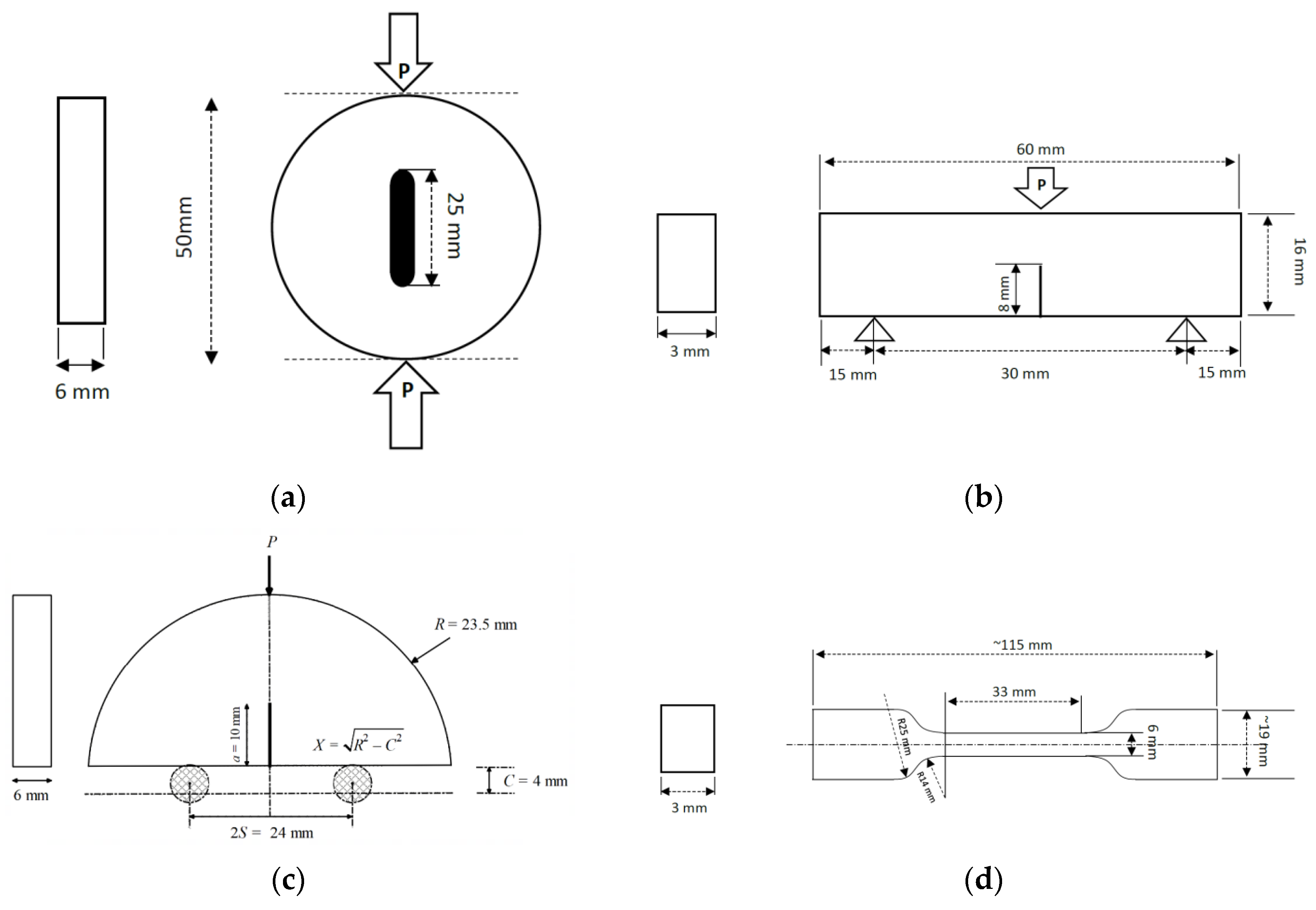

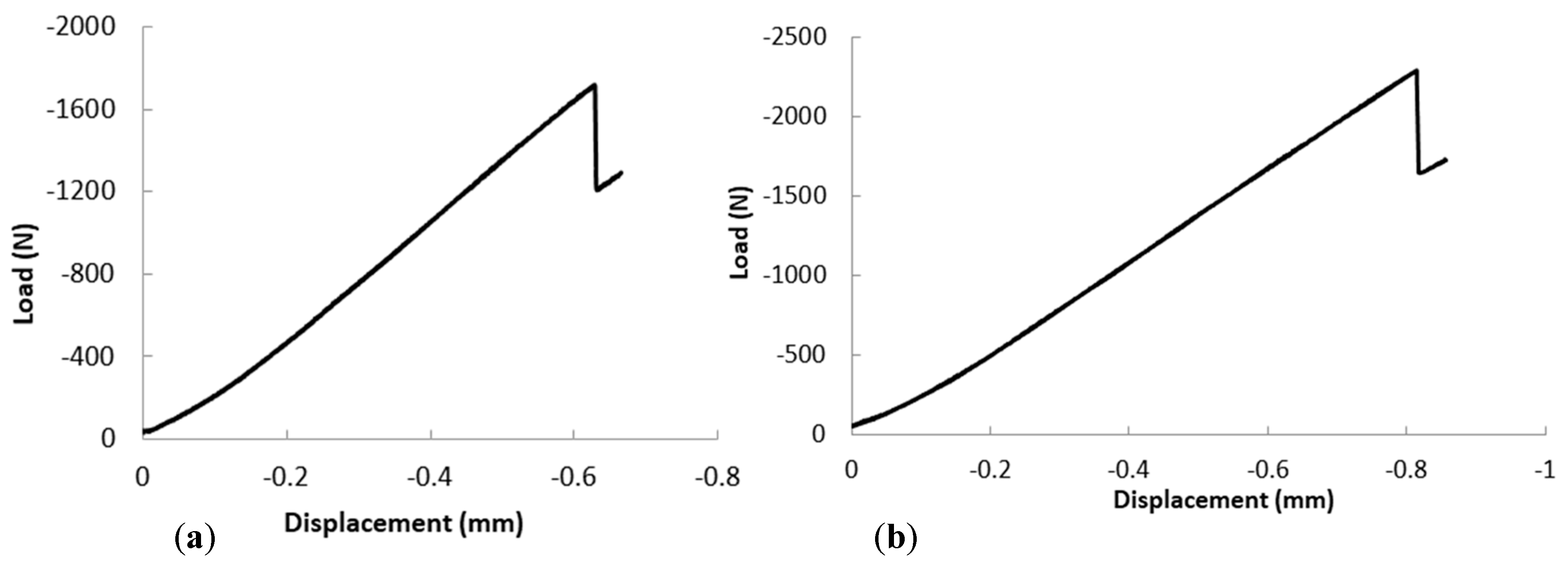
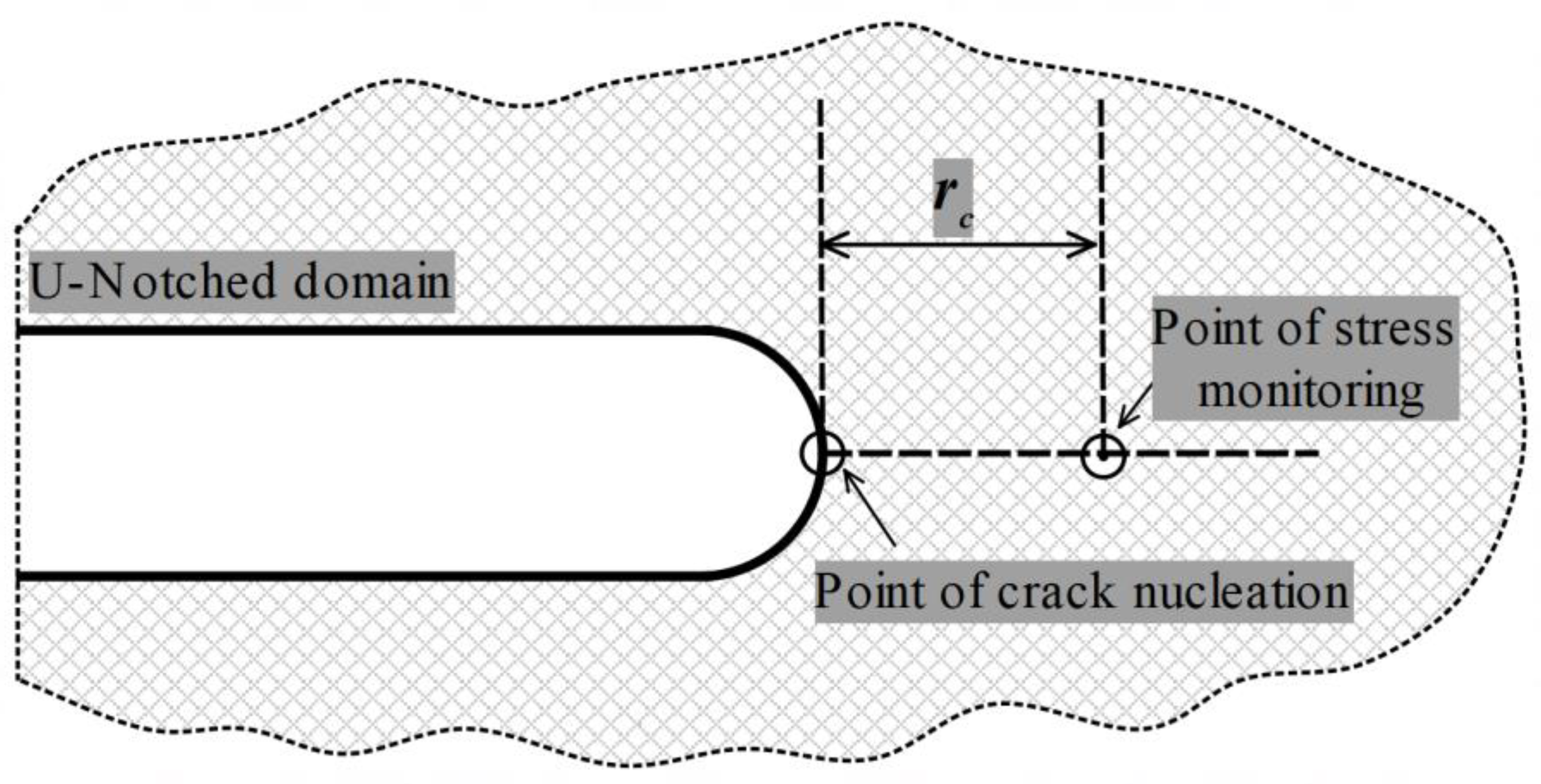
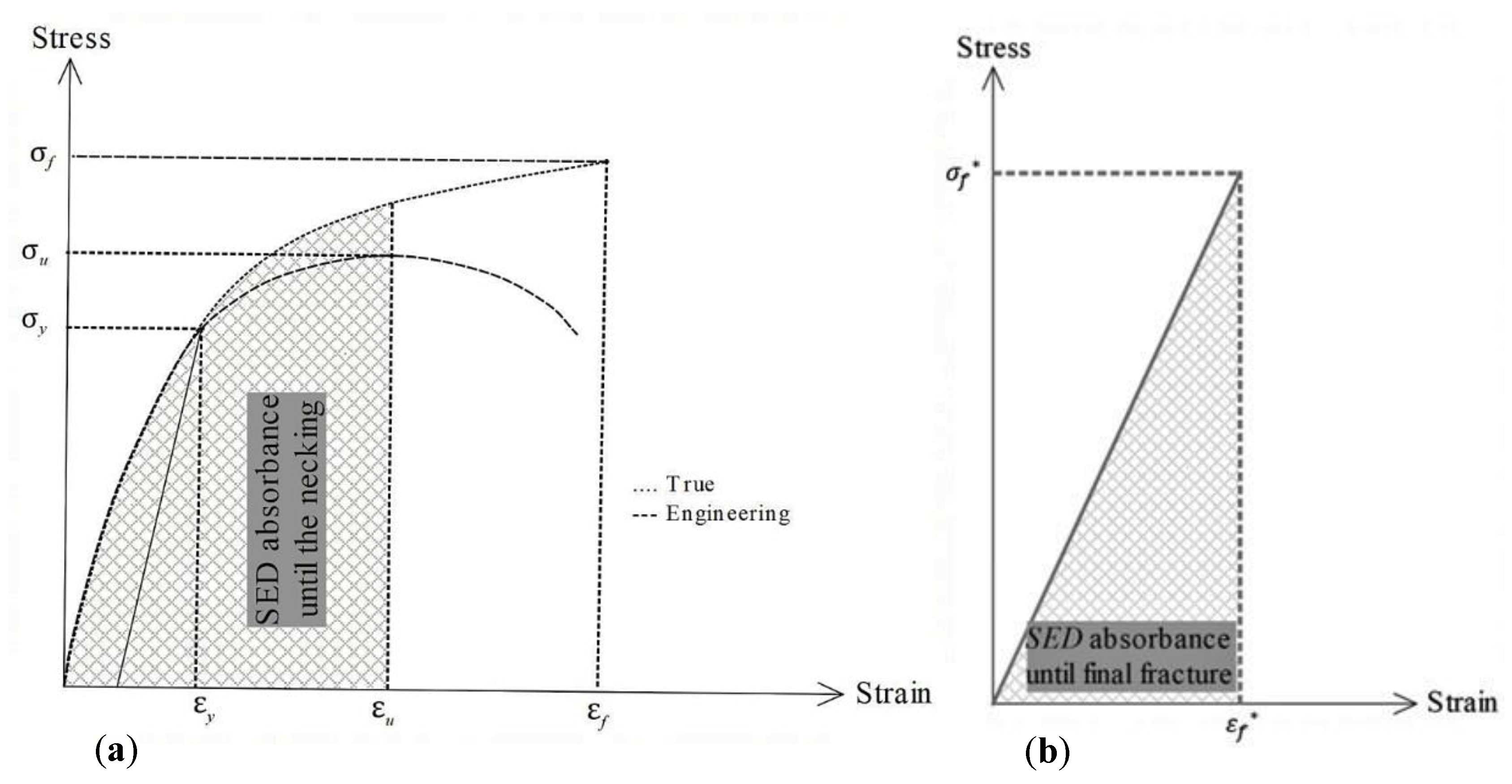

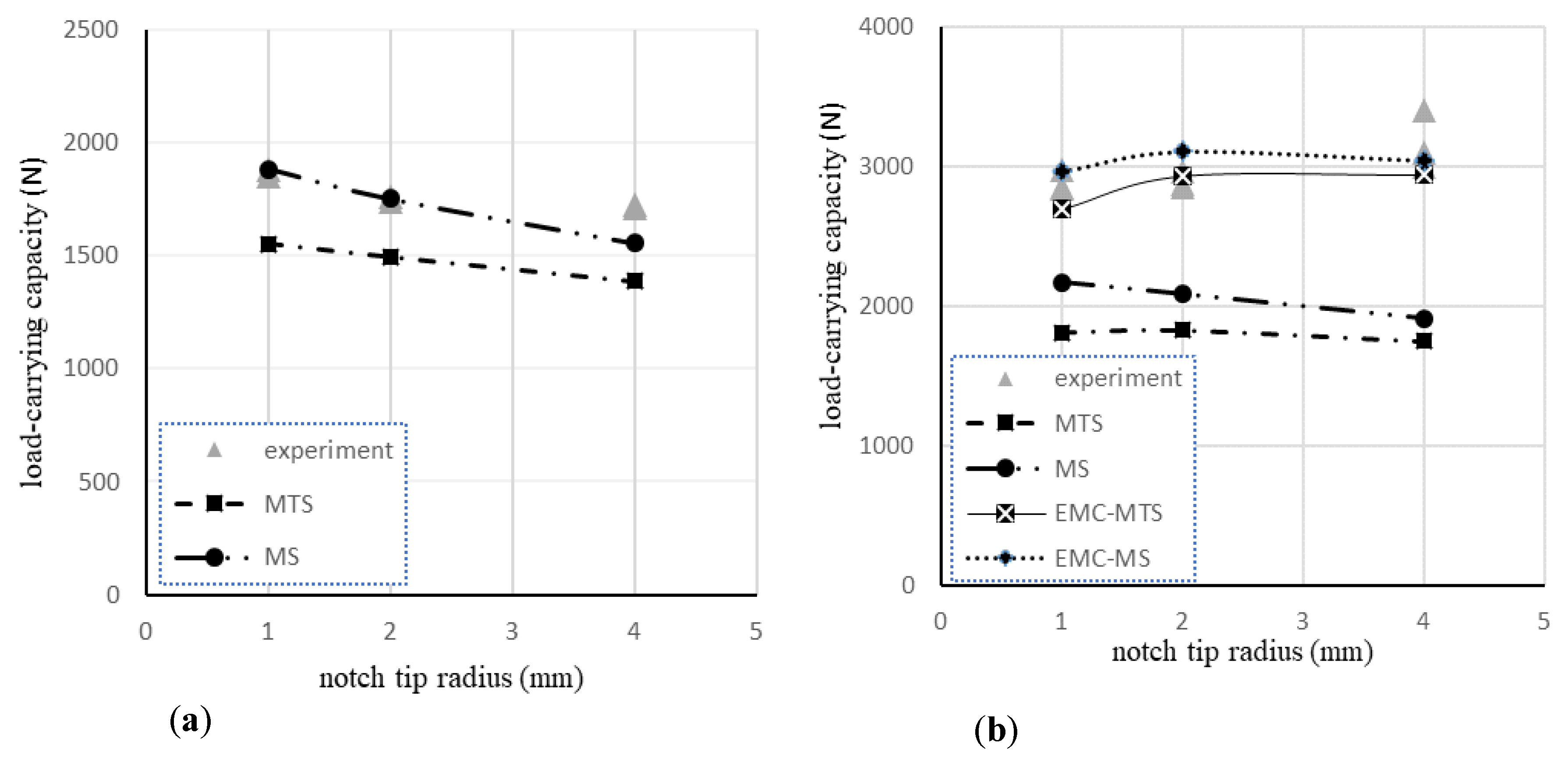
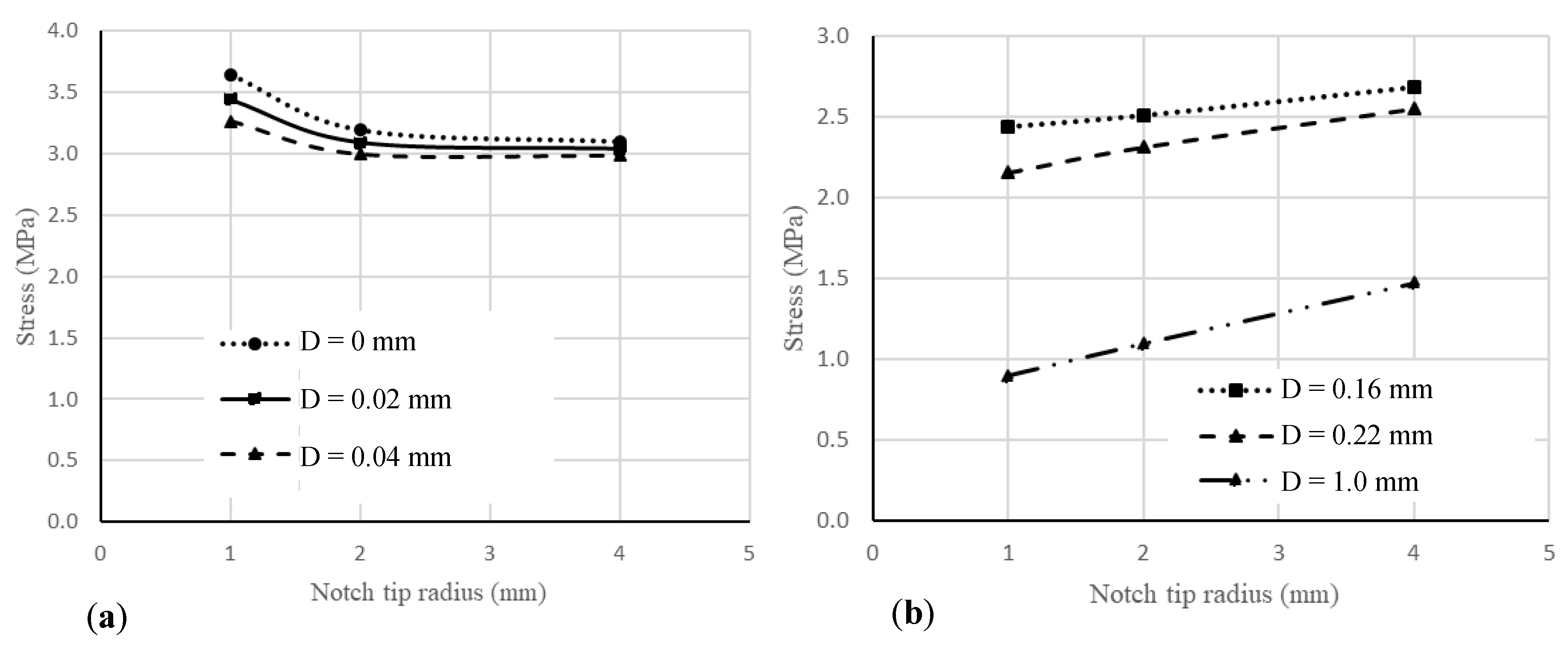
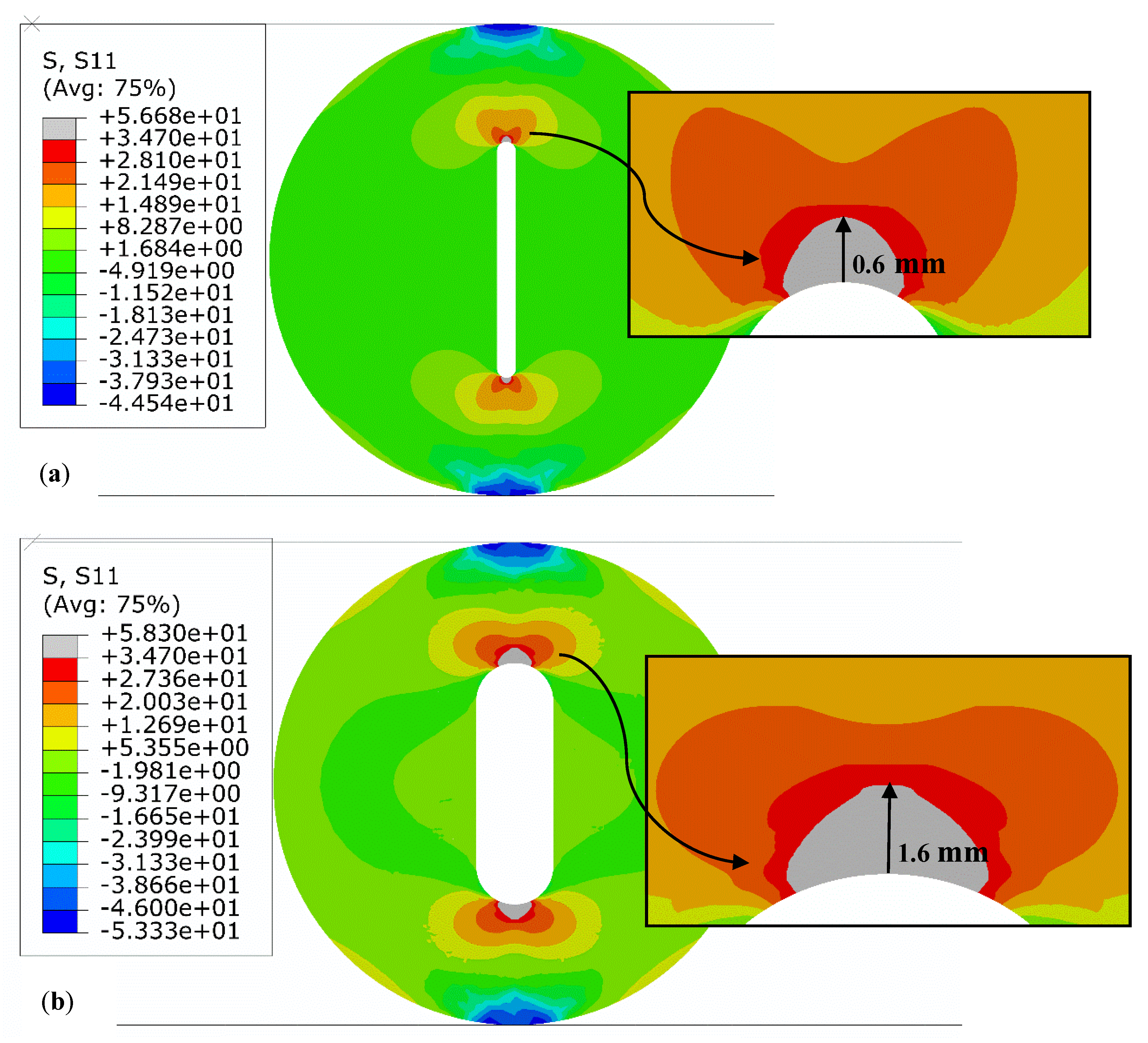
| Material Property | BC | DM |
|---|---|---|
| Elastic modulus, E (GPa) | 3.02 | 2.80 |
| Poisson’s ratio, υ | 0.3 | 0.3 |
| Ultimate tensile strength, σu (MPa) | 36.6 | 48.7 |
| Yield strength, σy (MPa) | N/A | 34.7 |
| Fracture toughness, KIC (MPa.m0.5) | 1.2 | 1.32 |
| Material | Specimen | P1 (N) | P2 (N) | P3 (N) | Pm (N) |
|---|---|---|---|---|---|
| BC | C-1 | 1850 | 1880 | - | 1865 |
| C-2 | 1740 | 1760 | - | 1750 | |
| C-4 | 1710 | 1730 | - | 1720 | |
| SCB-10 | 336 | 330 | - | 333 | |
| DM | C-1 | 2690 | 2723 | 2645 | 2686 |
| C-2 | 3280 | 3220 | 3226 | 3242 | |
| C-4 | 3265 | 3243 | 3257 | 3255 | |
| R-8 | 144 | 150 | 141 | 145 |
| Material | Specimen | MTS | MS | EMC-MTS | EMC-MS |
|---|---|---|---|---|---|
| BC | C-1 | −17 | +1 | - | - |
| C-2 | −15 | 0 | - | - | |
| C-4 | −19 | −9 | - | - | |
| DM | C-1 | −32 | −19 | 0 | 10 |
| C-2 | −43 | −35 | −9 | 4 | |
| C-4 | −45 | −40 | −7 | −4 |
Publisher’s Note: MDPI stays neutral with regard to jurisdictional claims in published maps and institutional affiliations. |
© 2020 by the authors. Licensee MDPI, Basel, Switzerland. This article is an open access article distributed under the terms and conditions of the Creative Commons Attribution (CC BY) license (http://creativecommons.org/licenses/by/4.0/).
Share and Cite
Shahbaz, S.; Ayatollahi, M.R.; Torabi, A.R.; Cicero, S. Fracture Behavior of Two Biopolymers Containing Notches: Effects of Notch Tip Plasticity. Appl. Sci. 2020, 10, 8445. https://doi.org/10.3390/app10238445
Shahbaz S, Ayatollahi MR, Torabi AR, Cicero S. Fracture Behavior of Two Biopolymers Containing Notches: Effects of Notch Tip Plasticity. Applied Sciences. 2020; 10(23):8445. https://doi.org/10.3390/app10238445
Chicago/Turabian StyleShahbaz, Sahel, Majid Reza Ayatollahi, Ali Reza Torabi, and Sergio Cicero. 2020. "Fracture Behavior of Two Biopolymers Containing Notches: Effects of Notch Tip Plasticity" Applied Sciences 10, no. 23: 8445. https://doi.org/10.3390/app10238445





